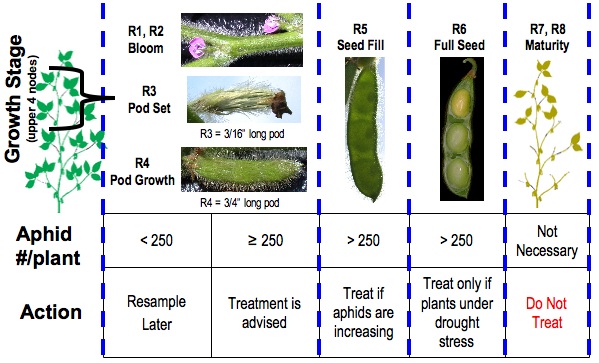It is late in the season but there is still one important insect pest to watch for in the next few weeks and that is the dreaded soybean aphid. There are several factors that could lead to a late outbreak:
1) The weather has been perfect for aphid development – temps in the low to mid-80's with relatively low humidity present ideal conditions for aphid reproduction. During our sweltering July aphids likely shut down for the most part, as they do not reproduce as rapidly at temperatures over 90.
2) There are many fields over threshold in northern Indiana and Michigan, and suction traps are capturing large numbers of winged aphids. Thanks to Dr. David Voegtlin, emeritus of the Illinois Natural History survey, we know that our Indiana suction traps (30' tall PVC tubes that suck in flying insects from overhead) have been starting to catch large numbers of migrating aphids. This is how the aphids colonize new areas and move away from areas that are too "crowded."
3) Many late-planted beans are still in vulnerable stages. Aphids will seek out the youngest beans they can find. These are the most nutritious for them, and the plants of course are most sensitive at these earlier development points. Southern Indiana producers, many of whom have many acres of late-planted beans, should be particularly vigilant.
Sampling: Count aphids, primarily on the undersides of leaves, on at least 20 plants in various areas of the field. When aphids are just beginning to colonize soybean plants, they will be concentrated on the most active growing points – the newest unrolled leaves and the developing pods.
Shortcuts: if aphids are observed on the petioles and stems, that plant is over 250 aphids. If honeydew and sooty-mold are obvious as you walk the field, the threshold has been exceeded.
Aphid Number: Should you find an average of 250 or more aphids/plant during the pod and seed development stages (R3-R4), a treatment is justified. Threshold of ≥250 aphids/plant includes a week to get field sprayed. During the seed-fill stages (R5-R6), treatment is not as clear-cut.
If aphid numbers are increasing and plants are under stress, however, a treatment is justified, see accompanying threshold graphic. Do NOT treat soybean beyond the R6 stage of growth, the plant is already beginning to senesce and any aphids that are there will not impact yield.







Post a comment
Report Abusive Comment